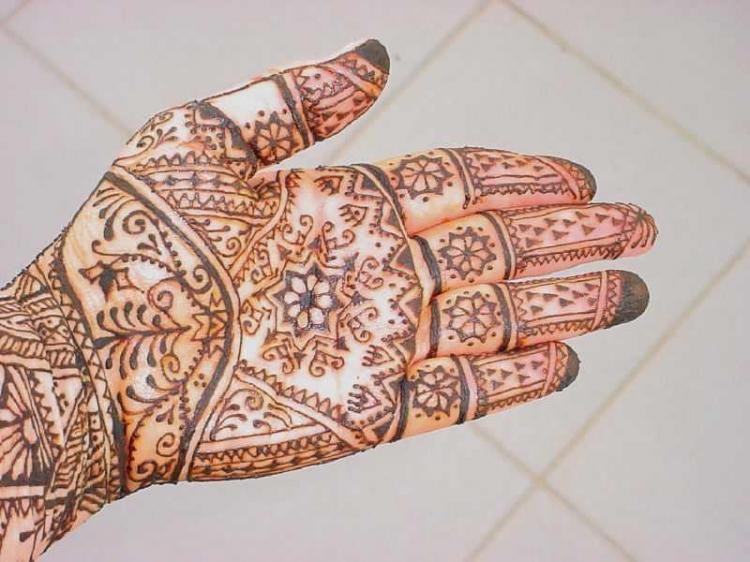The bush Lawsonia inermis—It grows in hot regions from the Western Sahara to Israel to India and is used for purposes as mundane as daily body decoration and as significant as marriage ceremonies. For 5,000 years, the body art known as henna has survived across Asia and Africa in its many forms.
The henna leaf is ground into a paste that is applied to the skin. The paste will harden into a crust in a little over 30 minutes, after which it can be scraped off.
The result is a stained pattern on the skin that lasts for anywhere from several days to several weeks before it fades away with the replacement of skin cells.
Today, commercial beauty products have harnessed the natural coloring properties of henna. For example, international beauty chain Lush sells a henna hair dye in blocks that are melted and applied to the hair.
Flowers and Peacocks
Henna paste is used in a paper or plastic tube similar to pastry chefs’ icing tubes. The henna artist holds the tube like she would a pen. With a gentle squeeze, the tube produces thin lines that compose intricate designs. What designs are prevalent in a given region is dependent on the area’s customs and religious mores.
An Eid celebration at the Tunisian Cultural Center in New York City was an exposé on the different styles of henna patterns.
According to a volunteer who did free henna for the ladies at the celebration, in India and Pakistan, paisley and peacock patterns are more prevalent whereas in other Muslim countries, floral designs are more prevalent because Islam prohibits image making. In some parts of Africa, large geometric patterns are used. In all mentioned cultures, though, henna is used for wedding ceremonies.
In India and Pakistan, henna designs are applied the night before the wedding during a bachelorette party of sorts. It is believed that if the henna comes out dark, her mother-in-law will love her.
In Ghana and West Africa, henna is applied all over both legs of the bride three days before her wedding. Her legs would be wrapped up the entire time. The idea is to cleanse her body in preparation for marriage.
The Plant
The henna plant requires a temperature of at least 60°F (11°C) year-round for the five years it takes to reach maturity. Soil properties effect henna’s coloration and moisture content. Arid areas such as Iran and Egypt produce leaves low in water and high in tannins, which make a better powdered henna for export. Henna grown in humid regions are generally used locally for this reason.
Henna from hot, dry regions result in deep brown stains when applied to the skin, while that from Pakistan tend to bear an orange tone.
Just because the paste is dark doesn’t mean that the stain will be dark or long-lasting, as it depends on the staining time, acidity, and temperature of the mixture, whether the plant received fertilizer, as well as the physical chemistry of its wearer.
Additives like lemon juice, sugar, essential oils and coffee are often added to henna paste to alter its coloration and wear time.
It’s impossible to tell by the packaging whether the henna will be quality or not, but if it claims to be “black henna,” or “Khidab,” beware. Black henna may contain Para-phenylenediamine (PPD), an ingredient in black hair dye that could cause blistering, swelling, and even localized loss of sensation if used on skin.
A good test is to see whether the powder itself is green or black. If it’s brownish-black or black, stay away.







